Abstract
Pulmonary alveolar macrophages (PAM), obtained by bronchoalveolar lavage from 47 individuals, reduced hexavalent chromium [Cr(VI)] and decreased its mutagenicity. Their specific activity--mostly mediated by cytosolic, enzyme-catalyzed mechanisms--was significantly higher than in corresponding preparations of mixed-cell populations from human peripheral lung parenchyma or bronchial tree, or from rat lung or liver. At equivalent number of PAM, Cr(VI) reduction, total protein, and some oxidoreductase activities were significantly increased in smokers. No appreciable variation could be detected between lung cancer and noncancer patients. In rats, the Cr(VI)-reducing activity of PAM preparations was induced by Aroclor 1254. Thus, alveolar macrophages provide crucial defense mechanisms not only by phagocytizing metals, but also by metabolically reducing Cr(VI). The epithelial-lining fluid (ELF) also displayed some Cr(VI) reduction. Together with already investigated metabolic processes occurring inside lung cells, these mechanisms are expected to determine thresholds in the pulmonary carcinogenicity of chromium.
Full text
PDF
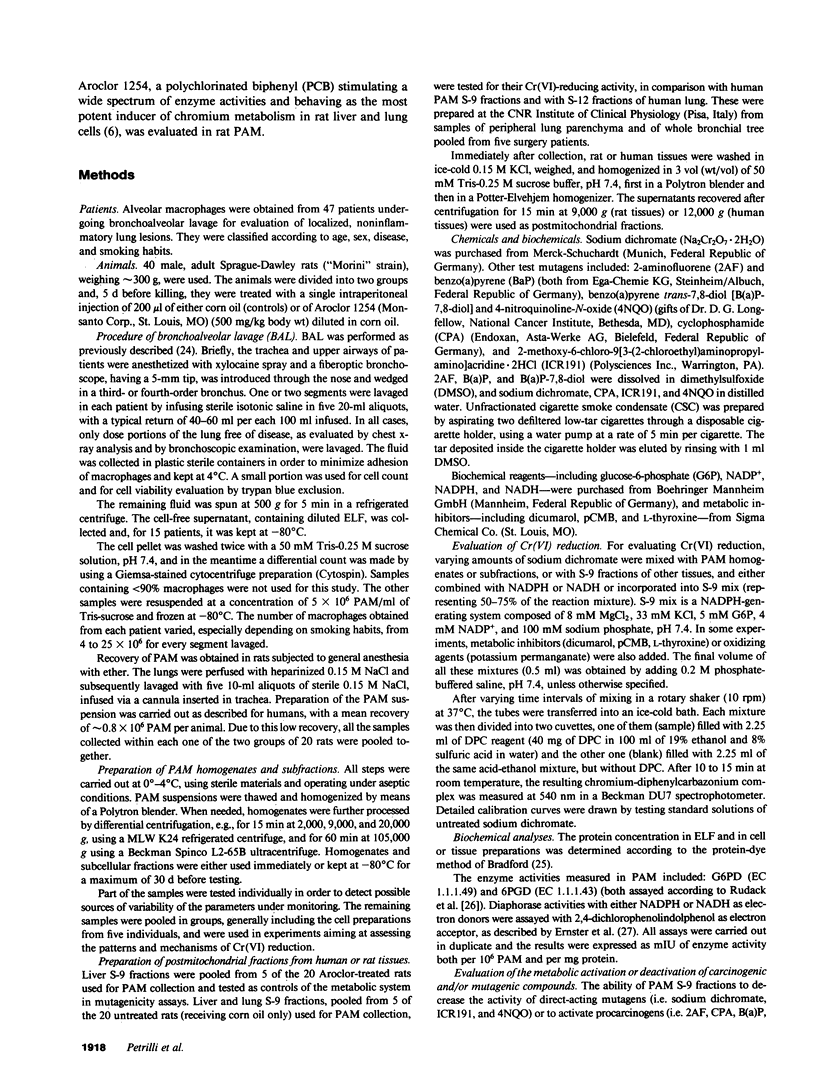
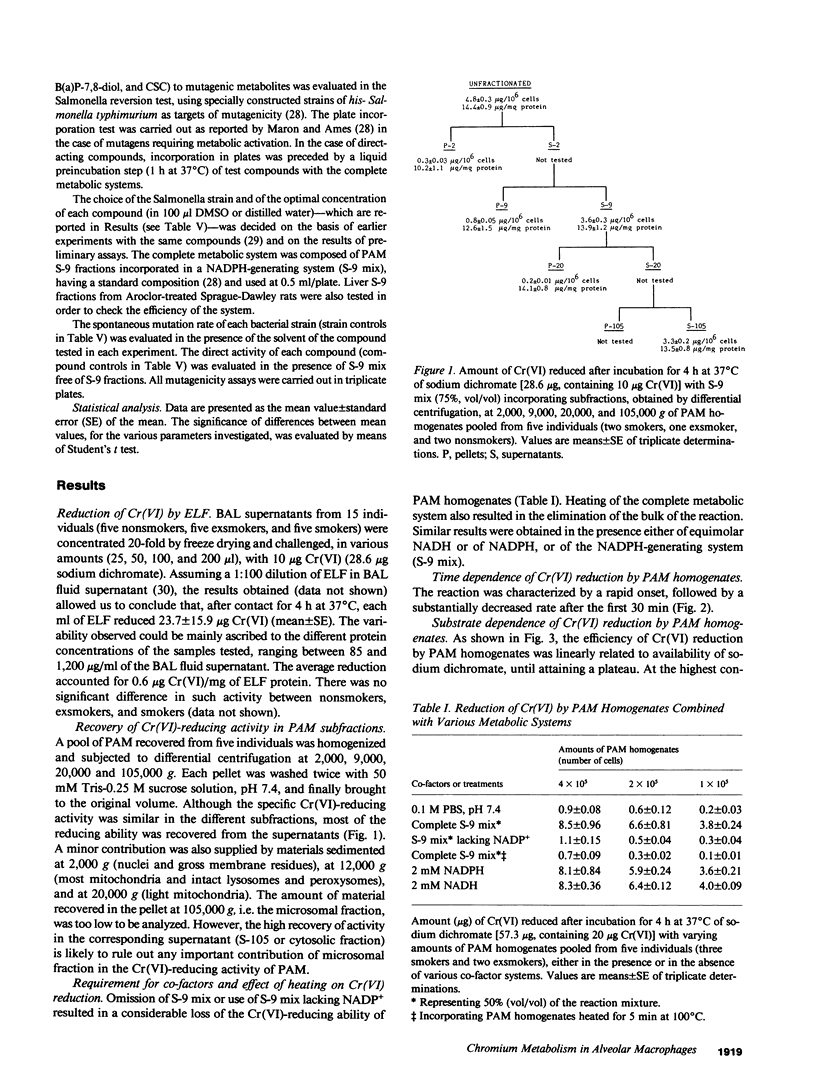

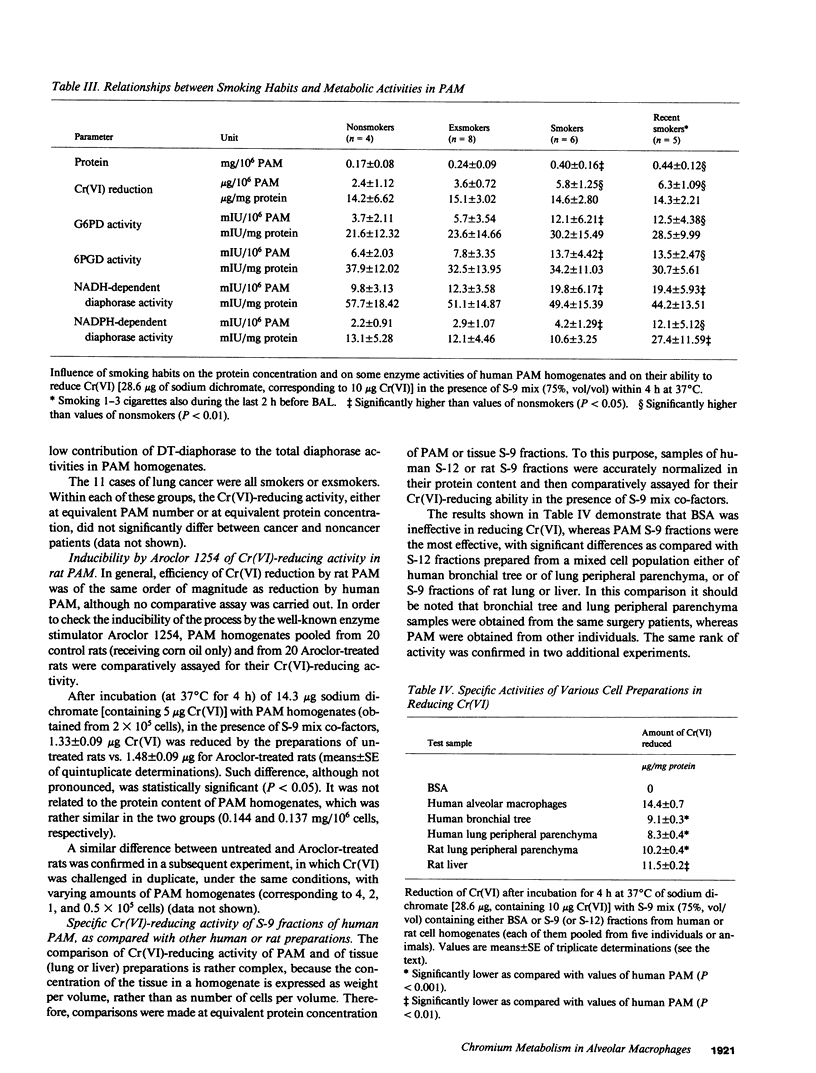
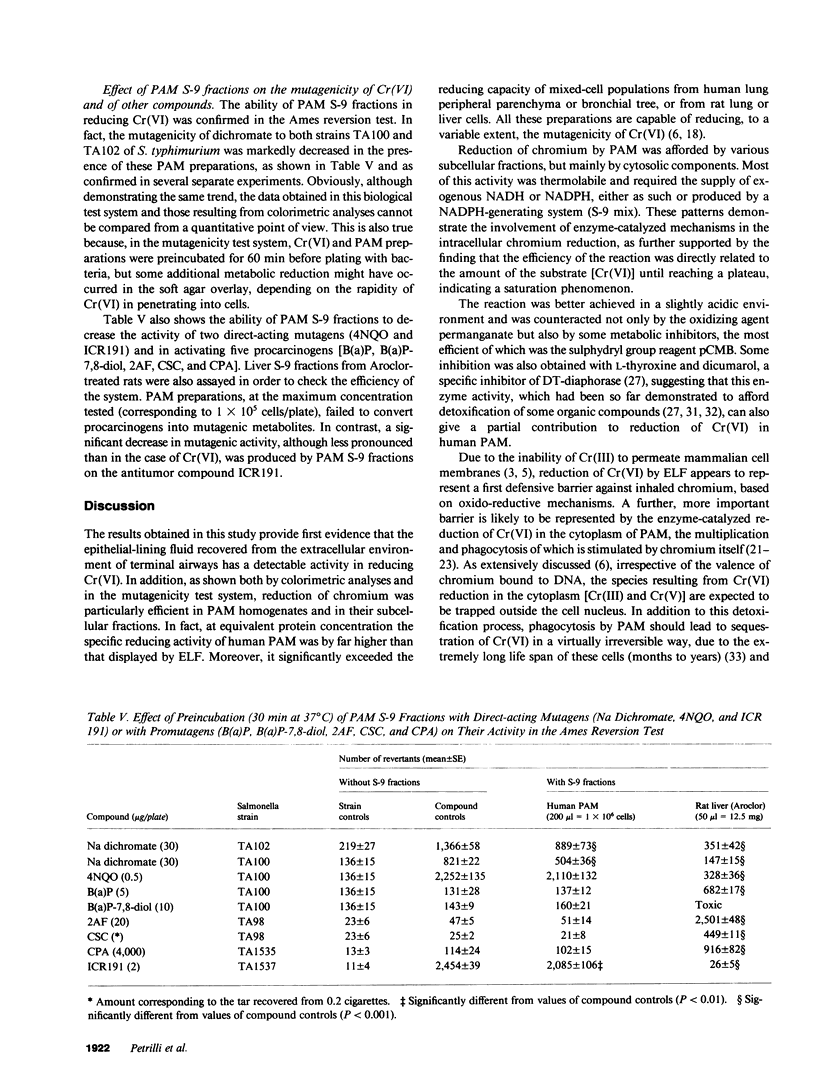
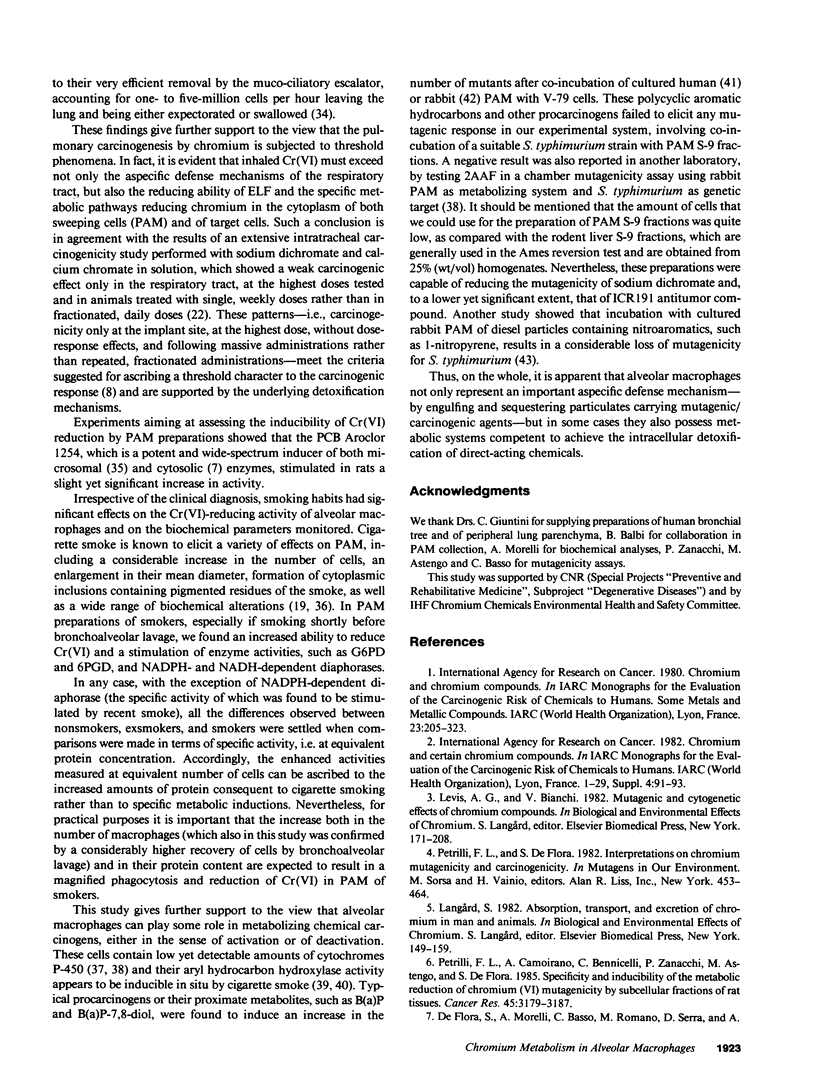
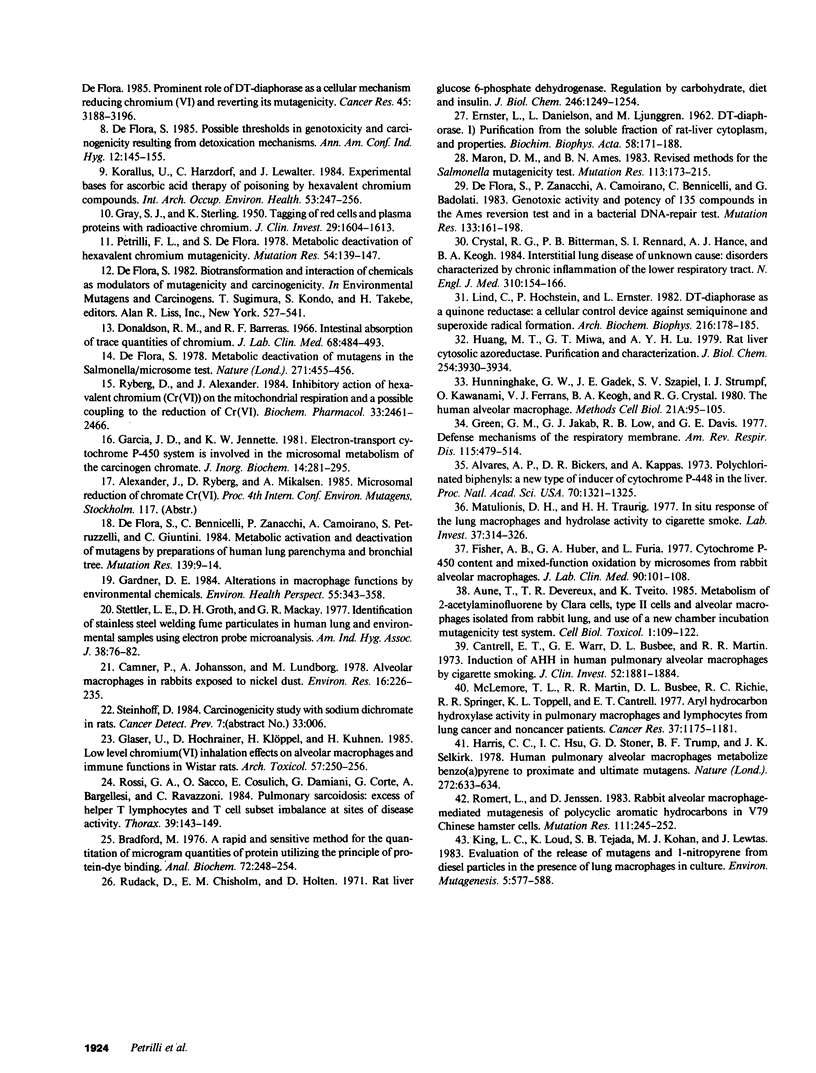
Selected References
These references are in PubMed. This may not be the complete list of references from this article.
- Alvares A. P., Bickers D. R., Kappas A. Polychlorinated biphenyls: a new type of inducer of cytochrome P-448 in the liver. Proc Natl Acad Sci U S A. 1973 May;70(5):1321–1325. doi: 10.1073/pnas.70.5.1321. [DOI] [PMC free article] [PubMed] [Google Scholar]
- Aune T., Devereux T. R., Tveito K. Metabolism of 2-acetylaminofluorene by Clara cells, type II cells and alveolar macrophages isolated from rabbit lung, and use of a new chamber incubation mutagenicity test system. Cell Biol Toxicol. 1985 Jun;1(3):109–122. doi: 10.1007/BF00120158. [DOI] [PubMed] [Google Scholar]
- Bradford M. M. A rapid and sensitive method for the quantitation of microgram quantities of protein utilizing the principle of protein-dye binding. Anal Biochem. 1976 May 7;72:248–254. doi: 10.1016/0003-2697(76)90527-3. [DOI] [PubMed] [Google Scholar]
- Camner P., Johansson A., Lundborg M. Alveolar macrophages in rabbits exposed to nickel dust. Ultrastructural changes and effect on phagocytosis. Environ Res. 1978 Jul;16(1-3):226–235. doi: 10.1016/0013-9351(78)90158-5. [DOI] [PubMed] [Google Scholar]
- Cantrell E. T., Warr G. A., Busbee D. L., Martin R. R. Induction of aryl hydrocarbon hydroxylase in human pulmonary alveolar macrophages by cigarette smoking. J Clin Invest. 1973 Aug;52(8):1881–1884. doi: 10.1172/JCI107371. [DOI] [PMC free article] [PubMed] [Google Scholar]
- Crystal R. G., Bitterman P. B., Rennard S. I., Hance A. J., Keogh B. A. Interstitial lung diseases of unknown cause. Disorders characterized by chronic inflammation of the lower respiratory tract (first of two parts). N Engl J Med. 1984 Jan 19;310(3):154–166. doi: 10.1056/NEJM198401193100304. [DOI] [PubMed] [Google Scholar]
- De Flora S., Bennicelli C., Zanacchi P., Camoirano A., Petruzzelli S., Giuntini C. Metabolic activation and deactivation of mutagens by preparations of human lung parenchyma and bronchial tree. Mutat Res. 1984 Jan;139(1):9–14. doi: 10.1016/0165-7992(84)90114-3. [DOI] [PubMed] [Google Scholar]
- De Flora S. Metabolic deactivation of mutagens in the Salmonella-microsome test. Nature. 1978 Feb 2;271(5644):455–456. doi: 10.1038/271455a0. [DOI] [PubMed] [Google Scholar]
- De Flora S., Morelli A., Basso C., Romano M., Serra D., De Flora A. Prominent role of DT-diaphorase as a cellular mechanism reducing chromium(VI) and reverting its mutagenicity. Cancer Res. 1985 Jul;45(7):3188–3196. [PubMed] [Google Scholar]
- De Flora S., Zanacchi P., Camoirano A., Bennicelli C., Badolati G. S. Genotoxic activity and potency of 135 compounds in the Ames reversion test and in a bacterial DNA-repair test. Mutat Res. 1984 May;133(3):161–198. doi: 10.1016/0165-1110(84)90016-2. [DOI] [PubMed] [Google Scholar]
- Donaldson R. M., Jr, Barreras R. F. Intestinal absorption of trace quantities of chromium. J Lab Clin Med. 1966 Sep;68(3):484–493. [PubMed] [Google Scholar]
- ERNSTER L., DANIELSON L., LJUNGGREN M. DT diaphorase. I. Purification from the soluble fraction of rat-liver cytoplasm, and properties. Biochim Biophys Acta. 1962 Apr 9;58:171–188. doi: 10.1016/0006-3002(62)90997-6. [DOI] [PubMed] [Google Scholar]
- Fisher A. B., Huber G. A., Furia L. Cytochrome P-450 content and mixed-function oxidation by microsomes from rabbit alveolar macrophages. J Lab Clin Med. 1977 Jul;90(1):101–108. [PubMed] [Google Scholar]
- GRAY S. J., STERLING K. The tagging of red cells and plasma proteins with radioactive chromium. J Clin Invest. 1950 Dec;29(12):1604–1613. doi: 10.1172/JCI102403. [DOI] [PMC free article] [PubMed] [Google Scholar]
- Garcia J. D., Jennette K. W. Electron-transport cytochrome P-450 system is involved in the microsomal metabolism of the carcinogen chromate. J Inorg Biochem. 1981 Jul;14(4):281–295. doi: 10.1016/s0162-0134(00)80286-x. [DOI] [PubMed] [Google Scholar]
- Gardner D. E. Alterations in macrophage functions by environmental chemicals. Environ Health Perspect. 1984 Apr;55:343–358. doi: 10.1289/ehp.8455343. [DOI] [PMC free article] [PubMed] [Google Scholar]
- Glaser U., Hochrainer D., Klöppel H., Kuhnen H. Low level chromium (VI) inhalation effects on alveolar macrophages and immune functions in Wistar rats. Arch Toxicol. 1985 Sep;57(4):250–256. doi: 10.1007/BF00324787. [DOI] [PubMed] [Google Scholar]
- Green G. M., Jakab G. J., Low R. B., Davis G. S. Defense mechanisms of the respiratory membrane. Am Rev Respir Dis. 1977 Mar;115(3):479–514. doi: 10.1164/arrd.1977.115.3.479. [DOI] [PubMed] [Google Scholar]
- Harris C. C., Hsu I. C., Stoner G. D., Trump B. F., Selkirk J. K. Human pulmonary alveolar macrophages metabolise benzo(a)pyrene to proximate and ultimate mutagens. Nature. 1978 Apr 13;272(5654):633–634. doi: 10.1038/272633a0. [DOI] [PubMed] [Google Scholar]
- Huang M. T., Miwa G. T., Lu A. Y. Rat liver cytosolic azoreductase. Purification and characterization. J Biol Chem. 1979 May 25;254(10):3930–3934. [PubMed] [Google Scholar]
- Hunninghake G. W., Gadek J. E., Szapiel S. V., Strumpf I. J., Kawanami O., Ferrans V. J., Keogh B. A., Crystal R. G. The human alveolar macrophage. Methods Cell Biol. 1980;21A:95–105. doi: 10.1016/s0091-679x(08)60760-8. [DOI] [PubMed] [Google Scholar]
- King L. C., Loud K., Tejada S. B., Kohan M. J., Lewtas J. Evaluation of the release of mutagens and 1-nitropyrene from diesel particles in the presence of lung macrophages in culture. Environ Mutagen. 1983;5(4):577–588. doi: 10.1002/em.2860050407. [DOI] [PubMed] [Google Scholar]
- Korallus U., Harzdorf C., Lewalter J. Experimental bases for ascorbic acid therapy of poisoning by hexavalent chromium compounds. Int Arch Occup Environ Health. 1984;53(3):247–256. doi: 10.1007/BF00398817. [DOI] [PubMed] [Google Scholar]
- Lind C., Hochstein P., Ernster L. DT-diaphorase as a quinone reductase: a cellular control device against semiquinone and superoxide radical formation. Arch Biochem Biophys. 1982 Jun;216(1):178–185. doi: 10.1016/0003-9861(82)90202-8. [DOI] [PubMed] [Google Scholar]
- Maron D. M., Ames B. N. Revised methods for the Salmonella mutagenicity test. Mutat Res. 1983 May;113(3-4):173–215. doi: 10.1016/0165-1161(83)90010-9. [DOI] [PubMed] [Google Scholar]
- Matulionis D. H., Traurig H. H. In situ response of lung macrophages and hydrolase activities to cigarette smoke. Lab Invest. 1977 Sep;37(3):314–326. [PubMed] [Google Scholar]
- McLemore T. L., Martin R. R., Busbee D. L., Richie R. C., Springer R. R., Toppell K. L., Cantrell E. T. Aryl hydrocarbon hydroxylase activity in pulmonary macrophages and lymphocytes from lung cancer and noncancer patients. Cancer Res. 1977 Apr;37(4):1175–1181. [PubMed] [Google Scholar]
- Petrilli F. L., Camoirano A., Bennicelli C., Zanacchi P., Astengo M., De Flora S. Specificity and inducibility of the metabolic reduction of chromium(VI) mutagenicity by subcellular fractions of rat tissues. Cancer Res. 1985 Jul;45(7):3179–3187. [PubMed] [Google Scholar]
- Petrilli F. L., De Flora S. Interpretations on chromium mutagenicity and carcinogenicity. Prog Clin Biol Res. 1982;109:453–464. [PubMed] [Google Scholar]
- Petrilli F. L., De Flora S. Metabolic deactivation of hexavalent chromium mutagenicity. Mutat Res. 1978 Oct;54(2):139–147. doi: 10.1016/0165-1161(78)90034-1. [DOI] [PubMed] [Google Scholar]
- Romert L., Jenssen D. Rabbit alveolar macrophage-mediated mutagenesis of polycyclic aromatic hydrocarbons in V79 Chinese hamster cells. Mutat Res. 1983 Oct;111(2):245–252. doi: 10.1016/0027-5107(83)90067-2. [DOI] [PubMed] [Google Scholar]
- Rossi G. A., Sacco O., Cosulich E., Damiani G., Corte G., Bargellesi A., Ravazzoni C. Pulmonary sarcoidosis: excess of helper T lymphocytes and T cell subset imbalance at sites of disease activity. Thorax. 1984 Feb;39(2):143–149. doi: 10.1136/thx.39.2.143. [DOI] [PMC free article] [PubMed] [Google Scholar]
- Rudack D., Chisholm E. M., Holten D. Rat liver glucose 6-phosphate dehydrogenase. Regulation by carbohydrate diet and insulin. J Biol Chem. 1971 Mar 10;246(5):1249–1254. [PubMed] [Google Scholar]
- Ryberg D., Alexander J. Inhibitory action of hexavalent chromium (Cr(VI)) on the mitochondrial respiration and a possible coupling to the reduction of Cr(VI). Biochem Pharmacol. 1984 Aug 1;33(15):2461–2466. doi: 10.1016/0006-2952(84)90718-4. [DOI] [PubMed] [Google Scholar]
- Stettler L. E., Groth D. H., MacKay G. R. Identification of stainless steel welding fume particulates in human lung and environmental samples using electron probe microanalysis. Am Ind Hyg Assoc J. 1977 Feb;38(2):76–82. doi: 10.1080/0002889778507917. [DOI] [PubMed] [Google Scholar]


